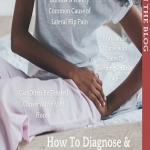
What is Trochanteric Bursitis?
Trochanteric bursitis is a common cause of lateral hip pain. A bursa is a small, jelly like sac that acts as a cushion to reduce friction in several locations in the body including the hip, knee, elbow, shoulder, and heel. Bursitis happens when the bursa becomes inflamed or swollen, causing increased friction, which causes increased inflammation or swelling.
There is a bony point of the hip called the greater trochanter, which the trochanteric bursa covers. Over the trochanteric bursa is the iliotibial band, or IT band.
What Causes It?
Several factors can cause this cycle of inflammation or bursitis, including injury to the lateral hip, increased use or overuse, leg length discrepancy, poor posture, changes in gait or walking pattern, previous surgery, and bone spurs or calcium deposits. There are also other diseases or conditions that can cause bursitis not listed here.

Common symptoms of trochanteric bursitis are:
- Pain along the lateral hip, thigh or buttock; pain with lying on the affected side
- Pain with pressing on the lateral hip; pain with stairs or standing from a seated position
- Increased discomfort after long periods of walking or activity.
Treatment
Treatment for trochanteric bursitis can often be accomplished at home. If you believe you have trochanteric bursitis and can take a non-steroidal anti-inflammatory medication (NSAID), this is often the first course of treatment. There are also topical gels or creams that can be purchased over the counter at your local pharmacy that may help with your discomfort. If your symptoms are severe, a visit to your orthopedic physician will give the opportunity for other treatment options including a cortisone injection and a prescription for physical therapy. You should also visit your health care provider if you notice any redness, warmth, or signs of infection along your hip.

Physical therapy and a consistent home exercise program can help keep chronic trochanteric bursitis at bay. Exercises to include in a home program include IT band stretches and core strengthening. Core stabilization and strengthening can help with gait patterns and posture which will help to decrease chances for return of symptoms. Stretching the IT band can decrease the pressure and friction along the trochanteric bursa over time, lessening the chance for a recurrent flare-up of symptoms.
Trochanteric bursitis is a condition that can be persistently bothersome. Don’t let your hip pain keep you sidelined from the activities you enjoy. No matter what caused your new or recurrent symptoms, we have physicians ready to meet you to evaluate, diagnose, and treat!
Author: Robin Dodd
Resources:
https://orthoinfo.aaos.org/en/diseases–conditions/hip-bursitis
https://my.clevelandclinic.org/health/diseases/4964-trochanteric-bursitis

